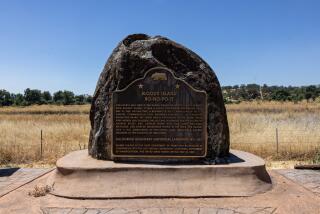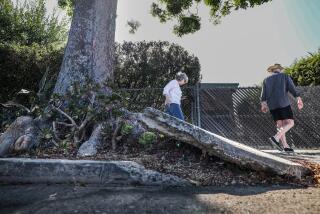1 street, 2 names adds up to many lost
- Share via
Out-of-towners Diego Jimenez and Cynthia Sanchez were lost. And not just because they were asked if they knew how to get to Tom Bradley Boulevard.
They were standing next to the downtown Los Angeles street that major Internet map services call Tom Bradley Boulevard. Problem is, the street sign over their heads identified the busy roadway as 1st Street.
Jimenez, 20, and Sanchez, 18, both of Porterville, had no idea where the street named after Los Angeles’ first black mayor was. They were searching for the county’s Hall of Records, in fact, and they didn’t know where that was either.
The pair were handed MapQuest and Google maps that labeled the street behind them “Tom Bradley Boulevard.” Nowhere in sight, however, was any street sign with the late L.A. leader’s name on it.
“This is very confusing,” said Jimenez, glancing between the map and the 1st Street sign.
It turns out that Jimenez and Sanchez aren’t the only ones confused by the street name.
The popular mapping websites have begun including directions with driving instructions such as “From Los Angeles, start out going SE on Tom Bradley Blvd. toward S. Los Angeles St. and turn left onto. . . .” Merchants along the eight-block stretch are beginning to wonder what street they’re on.
And those at Los Angeles City Hall are wondering what actually did happen May 25, 2001, when the City Council voted on a proposal to honor the late mayor. Did they change it to Tom Bradley Boulevard? Or did they keep the 1st Street name?
That day the council voted 10 to 0 to honor Bradley by ordering that ceremonial signs be placed between Hope and San Pedro streets “indicating this portion of 1st Street is also called “Tom Bradley Boulevard.”
Concurrently, however, they also voted 10 to 0 to order the city attorney to “take the necessary steps to rename a portion of 1st Street from San Pedro Street to Hope Street as ‘Tom Bradley Boulevard’ as provided for in Section 19.1 et seq.” of the city administrative code. Those code sections spell out the procedures necessary to make a name change official.
Both of the council motions identically spoke of Bradley’s “enormous legacy to the city which he led as mayor for an unprecedented 20 years, a legacy which will never be equaled, a legacy of shaping Los Angeles into the metropolis it is today, of bringing together all divergent groups and interests and making diversity our strength instead of our weakness.”
None of the council members from that era remain in office. But a tape recording of the panel’s 2001 meeting indicates that there was no discussion of either motion. The two were lumped together with eight unrelated matters. It took less than six seconds for the city clerk to record the unanimous vote of approval.
Officials in the city attorney’s office indicated they were puzzled by the double, dueling, street name actions taken more than six years ago. “We’ve asked the city clerk to explain it to us,” said a spokesman for City Atty. Rocky Delgadillo.
Others at City Hall were also scratching their heads.
“Is it honorary? That’s what it sounds like to me. It isn’t very clear. It’s got me confused,” said James Randall Price, manager of the mapping division of the city’s Bureau of Engineering. “We do not have Tom Bradley Boulevard in our database. We probably should. For some reason, it didn’t get in.”
The city doesn’t supply private companies with official maps anyway, he said.
A Google spokeswoman said her company “licenses its data from third-party data providers.” The map showing Tom Bradley Boulevard came from Navteq, a Chicago-based firm that provides information used in automotive navigational systems and Web-based maps.
MapQuest officials did not respond to several requests for comment. But a copyright notice on the bottom of its Tom Bradley Boulevard map indicated it was also created from Navteq data.
Navteq executives said their mapping database frequently has multiple names for streets, including legal names, vanity and ceremonial names and alternative spellings.
“Often our customers who make the end-user application have to make choices about which street name to use as a default in their system. Many opt to go with the legal name,” said Kelly Smith, vice president of marketing for Navteq.
The company gathers names from local contacts, postal files, legal records and things such as parcel data, he said. “In a case like this where there are multiple choices available, many application developers will opt for what is legally correct,” Smith said.
Proposals to change street names in Los Angeles inevitably lead to controversy.
Complaints from Los Feliz-area residents prompted the city in 1971 to reject crooner Rudy Vallee’s attempt to rename his street Rue de Vallee. So he slapped the name instead on his private driveway.
Grumbles from some in South Los Angeles failed to stop officials in 1983 from renaming venerable Santa Barbara Avenue as Martin Luther King Jr. Boulevard, in honor of the slain civil rights leader. Ten years later, old-timers in Boyle Heights complained but were unable to keep Brooklyn Avenue from becoming Cesar E. Chavez Avenue, honoring the late farm workers union leader.
Short stretches of roads are easier to rename. A block-long section of San Pedro Street near Little Tokyo was dubbed Judge John Aiso Street after the 1987 death of the former state Court of Appeal justice.
Redesignation of a similar-length section of nearby Weller Court was also embraced by the Japanese American community in 1986 when it became Ellison S. Onizuka Street, after an astronaut killed in the space shuttle Challenger disaster.
The name of a two-block street in an empty area of Bunker Hill was changed from 2nd Place to Gen. Thaddeus Kosciuszko Way in 1978 to honor the Polish-born Revolutionary War hero.
Four years ago, an attempt by the city to rename a stretch of Crenshaw Boulevard between Wilshire Boulevard and 79th Street for Bradley was withdrawn after Crenshaw district residents and business owners objected to what they cited as the loss of “75 years of identity.” In heeding the complaints, City Council members noted that Bradley’s name already graced the street outside their own City Hall.
Back on 1st Street -- or is it Tom Bradley Boulevard? -- several of the ceremonial signs are visible high on streetlight poles in the vicinity of City Hall and in Little Tokyo, just south of San Pedro Street.
Bradley, who died in 1998 at 80, is also honored in various other places around town. A reception room at the top of the City Hall tower bears his name, as does the international terminal at Los Angeles International Airport, a wing of the downtown Central Library (which itself is named after former Mayor Richard Riordan), a meeting hall at UCLA, a hall at the Los Angeles Convention Center, and a youth and family center on West Pico Boulevard.
Few passersby seem to notice the “Bradley Boulevard” signs, however. Aside from the Los Angeles Times, only a dozen or so merchants are located along the eight-block strip that is home to mostly government buildings.
“My goodness. All of our mail goes to 1st Street,” said Tsuyako Kunishige, who has worked at the S.K. Uyeda store, a Japanese apparel shop, for 18 years. “I’ve never heard of this before.”
Visitors Jimenez and Sanchez, it turned out, weren’t looking for 1st Street or Tom Bradley Boulevard. They were seeking Temple Street and the county Hall of Records, where they hoped to obtain a copy of Sanchez’s birth certificate.
“We’ve been walking around lost for an hour,” said Sanchez, who works as a photo technician for Wal-Mart.
“We got our directions from the Internet. And we got lost.”
More to Read
Sign up for Essential California
The most important California stories and recommendations in your inbox every morning.
You may occasionally receive promotional content from the Los Angeles Times.














